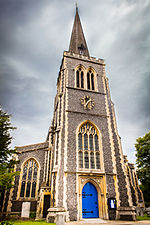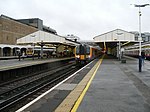Wimbledon High School
1880 establishments in EnglandBuildings and structures in Wimbledon, LondonEducational institutions established in 1880Member schools of the Girls' Schools AssociationPrivate girls' schools in London ... and 3 more
Private schools in the London Borough of MertonSchools of the Girls' Day School TrustUse British English from February 2023
Wimbledon High School is an independent girls' day school in Wimbledon, South West London. It is a Girls' Day School Trust school and is a member of the Girls' Schools Association.
Excerpt from the Wikipedia article Wimbledon High School (License: CC BY-SA 3.0, Authors).Wimbledon High School
Mansel Road, London Wimbledon Village (London Borough of Merton)
Geographical coordinates (GPS) Address Website External links Nearby Places Show on map
Geographical coordinates (GPS)
| Latitude | Longitude |
|---|---|
| N 51.4226 ° | E -0.2107 ° |
Address
Wimbledon High School
Mansel Road
SW19 4AB London, Wimbledon Village (London Borough of Merton)
England, United Kingdom
Open on Google Maps









